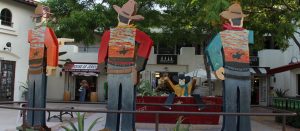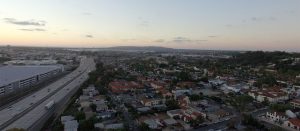Walk over to Presidio Hill and view the documentation of the birthplace of California! Old Town’s steep history within the California books is rich with action, adventure and cultural influence from around the world.
 The earliest indications of people living in San Diego date back 9,000 years. They called themselves Kumeyaay. When the Spaniards arrived, they used the word Diegueño to identify the Indians associated with the Mission. In 1542 explorer Juan Rodriguez Cabrillo reported that the native indians, “were good natured and an attractive people.” With the arrival of the Spanish settlements in 1769, many Kumeyaay retreated to the hills.
The earliest indications of people living in San Diego date back 9,000 years. They called themselves Kumeyaay. When the Spaniards arrived, they used the word Diegueño to identify the Indians associated with the Mission. In 1542 explorer Juan Rodriguez Cabrillo reported that the native indians, “were good natured and an attractive people.” With the arrival of the Spanish settlements in 1769, many Kumeyaay retreated to the hills.
Californio
Californio (historic and regional Spanish for “Californian”) is a term used to identify a Spanish-speaking, mostly Roman Catholic people, or of Latin American descent, regardless of race, born in California from the first Spanish colonies established by the Portolá expedition in 1769 to the Treaty of Guadalupe Hidalgo in 1848, in which Mexico ceded California to the United States. Descendants of Californios are also sometimes referred to as Californios. The much larger population of indigenous peoples of California were not Californios because they were not native Spanish-speakers. Neither were the significant numbers of non-Spanish-speaking California-born children of resident foreigners.
The military, religious and civil components of pre-1848 Californio society were embodied in the thinly populated presidios, missions, pueblos and ranchos. Until they were secularized in the 1830s, the twenty-one Spanish Missions of California, with their thousands of more or less captive native converts, controlled the most (about 1,000,000 acres (4,000 km2) per Mission) and best land, had large numbers of workers, grew the most crops and had the most sheep, cattle and horses. After secularization, most of the Mission lands were divided up into new ranchos and granted to Mexican citizens (including many Californios) resident in California.
The Spanish colonial and later Mexican national governments encouraged settlers from the Northern and western provinces of Mexico, as well people from other parts of Latin America, most notably Peru and Chile, to settle in California. They encouraged new settlers to become Spanish and/or Mexican citizens, including suggested conversion to the Roman Catholic Church.
The FOUNDING of CALIFORNIA
Old Town San Diego is considered the “birthplace” of California. San Diego is the site of the first permanent Spanish settlement in California. It was here in 1769, that Father Junipero Serra came to establish the very first mission in a chain of 21 missions that were to be the cornerstone of California’s colonization. Father Serra’s mission and Presidio were built on a hillside overlooking what is currently known as Old Town San Diego. At the base of the hill in 1820’s, a small Mexican community of adobe buildings was formed and by 1835 had attained the status of El Pueblo de San Diego. In 1846, a U.S. Navy Lieutenant and a Marine Lieutenant, raised the American flag in the Old Town San Diego Plaza.
In 1968, the State of California Department of Parks and Recreation established Old Town State Historic Park to preserve the rich heritage that characterized San Diego during the 1821 to 1872 period. The park includes a main plaza, exhibits, museums and living history demonstrations.
Historic buildings include La Casa de Estudillo, La Casa de Bandini, La Casa de Altamirno Pedrorena and the Mason Street School, San Diego’s first one room schoolhouse. Just up the hill from Old Town San Diego Historic State Park, you’ll find Heritage Park where several of San Diego’s most notable Victorian homes have been relocated and authentically restored to their original splendor. Just a short walk down San Diego Avenue is the Whaley House, an officially designated haunted house, the Little Adobe Chapel on Conde Street, the first Church in Old Town San Diego and El Campo Santo on San Diego Avenue, a 1850 Catholic Cemetery.

Come visit the original and reconstructed buildings and furnishings that illustrate the ambiance of 1800’s San Diego . . . where California Began!
THE WORKS OF HUBERT HOWE BANCROFT, HISTORY OF CALIFORNIA
The History Company, 1886, volume I, p. 133
Background, the visitador general of New Spain, José de Galvez in 1768 organized an expedition to occupy and fortify San Diego and Monterey. Two ships from that expedition, San Cårlos and San Antonio had anchored in San Diego Bay in April, 1769. Their crews were suffering from scurvy and dying. The expedition had located fresh water and food at the indian village of Kosa’aay. The two ships had been moved into the Bay as close as possible to the village. They expedition was on a daily basis hauling water and food from the village to the ships, about 2 leagues south. The expedition had not moved closer to the village because of concern about security from indian attack. On May 14 a land contingent of the expedition led by Rivera y Moncada with twenty-five soldados de cuera, soldiers
arrived and joined with the personnel of the two ships.
“The first thing to be done, now that the coming of Rivera’s men renders it possible, is to prepare for permanent settlement. The old camp, or pesthouse on the bay shore, is probably within the limits of what is now the city of San Diego, locally known as New Town; but the day after his arrival Rivera–so say the chroniclers, although according to the instructions of Galvez, Fages was chief in command–selects a new site some miles north, at what is now Old, or North, San Diego, at the foot of a hill on which are still to be seen the remains of the old presidio. Here camp is pitched and fortified, a corral for the animals and a few rude huts are built, and hither on the seventeenth are transported the sick and their tents.
The immediate purpose is that the camp may be near the river which at this point flows into the north end of the Bay. For six weeks officers, priests, and soldiers are occupied in attending to the wants of the sick and in unloading the San Antonio. Then they await the arrival of Portolá.”
Documentation that the birthplace of California was at the foot of Presidio Hill.


